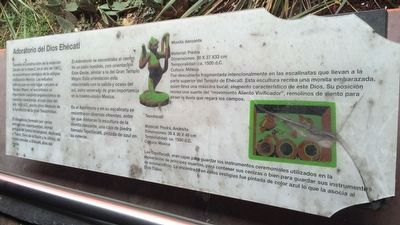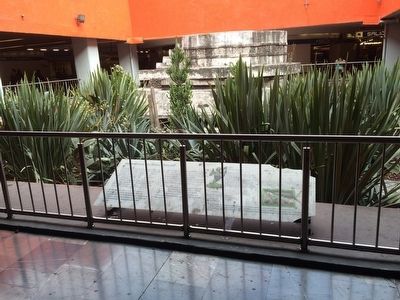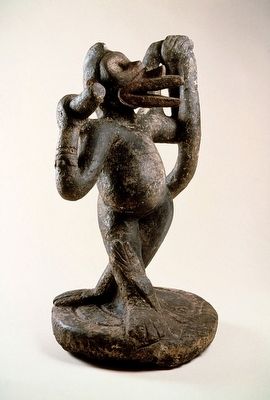Centro Histórico in Ciudad de México, Mexico — The Valley of Mexico (The Central Highlands)
Ceremonial Shrine of Ehécatl
Adoratorio del Dios Ehécatl
Inscription.
Durante la construcción de la estación Zócalo de la línea 2, en el año de 1967, se encontraron vestigios de la antigua civilización Mexica. Los estudios indican que en este lugar, cercano al Templo Mayor, se encontraba un importante conjunto arquitectónico de carácter ceremonial, el cual data del año 1400 d.C., pocos años después de la fundación de la gran Tenochtitlan.
El Adoratorio formado por varias estructuras superpuestas, la más antigua de forma rectangular, dedicada a Tláloc, Dios de la lluvia y la última, de forma circular, Ehécatl, dios del viento.
El Adoratorio se encontraba al centro de un patio hundido, con orientación Este-Oeste, similar a la Gran Templo Mayor. Esta orientación esta relacionada con la salida y ocaso del sol, astro venerado de gran importancia en la cosmo-visión Mexica.
En el Adoratorio y en su escalinata se encontraron diversas ofrendas, entre las que destacan la escultura de la monita danzante, una caja de piedra llamada Tepetlacalli, pintada de azul en su exterior.
Monita danzante
Material: Piedra
Dimensiones: 30 X 37 X33 cm
Temporalidad: ca. 1500 d.C.
Cultura: Mexica
Fue descubierta fragmentada intencionalmente en las escalinatas que lleva a la parte superior del Templo de Ehécatl. Esta escultura recrea una monita embarazada, quien lleva una máscara bucal, elemento característico de este Dios. Su posición, recrea una suerte del “movimiento Aliento Vivificador”, remolinos de viento para atraer la lluvia que regara los campos.
Tepetlacalli
Material: Piedra, Andesita
Dimensiones: 39 X 36 X 49 cm
Temporalidad: ca. 1500 d.C.
Cultura: Mexica
Los Tepetlacalli, eran cajas para guardar los instrumentos ceremoniales utilizados en la incineración de príncipes muertos, para contener sus cenizas o bien para guardar sus instrumentos de autosacrificio. La encontrada en estos vestigios fue pintada de color azul lo que la asocia al Dios Tláloc.
During the construction of the Metro line number 2 from the Zócalo in 1967, the remains of the ancient Mexica civilization were found. Studies indicate that here, close to the Templo Mayor, was a major architectural ceremonial complex, which dates back to 1400 AD, a few years after the founding of Tenochtitlan.
The Adoratorio (ceremonial structure) consists of several superimposed structures, with the oldest rectangular structures dedicated to Tláloc, the god of rain, and the latter, circular structures dedicated to Ehécatl, god of wind.
The
Adoratorio was at the center of a sunken patio, facing east-west, similar to the Great Templo Mayor. This orientation is related to sunrise and sunset, due to the sun’s great importance in the Mexica view of the universe.
On the shrine and its stairway various offerings were found, among which were a sculpture of a dancing monkey and a stone box called Tepetlacalli, painted blue on the outside.
The Dancing Monkey
Material: Stone
Dimensions: 30 X 37 X33 cm
Era: ca. 1500 A.D.
Culture: Mexica
This sculpture was intentionally broken at some time in the past and was discovered on the steps leading to the top of the Temple of Ehécatl. This sculpture recreates a pregnant monkey wearing a mouth mask, a characteristic element of this god Ehécatl. Her position recreates a pose called the "Life-giving breath movement", which was a portion of a dance to bring the rain that was so important for the watering of fields.
Tepetlacalli
Material: Stone, Andesit
Dimensions: 39 X 36 X 49 cm
Era: ca. 1500 A.D.
Culture: Mexica
Tepetlacalli were boxes for storing the ceremonial instruments used in the incineration of dead princes and also to contain their ashes or to save their instruments related to self-sacrifice. The remains of this box were painted blue, a color associated with the god Tláloc.
Topics. This historical marker is listed in these topic
lists: Anthropology & Archaeology • Churches & Religion • Native Americans. A significant historical year for this entry is 1400.
Location. 19° 25.512′ N, 99° 7.963′ W. Marker is in Ciudad de México. It is in Centro Histórico. The marker is inside the Pino Suárez Metro stop at the corners of Calles José María Izazaga and San Antonio Abad. Touch for map. Marker is in this post office area: Ciudad de México 06080, Mexico. Touch for directions.
Other nearby markers. At least 8 other markers are within walking distance of this marker. Temple of San Miguel Arcángel (about 150 meters away, measured in a direct line); Elias Nahum (approx. 0.3 kilometers away); Khojaly Monument (approx. 0.3 kilometers away); Temple of San José de Gracia (approx. 0.4 kilometers away); Juana Inés de la Cruz (approx. 0.4 kilometers away); Joaquin Noreña (approx. 0.4 kilometers away); Hernando Cortés (approx. 0.4 kilometers away); The First Cathedral of Mexico City (approx. 0.4 kilometers away). Touch for a list and map of all markers in Ciudad de México.
Credits. This page was last revised on January 4, 2023. It was originally submitted on December 3, 2015, by J. Makali Bruton of Accra, Ghana. This page has been viewed 405 times since then and 16 times this year. Photos: 1, 2, 3. submitted on December 3, 2015, by J. Makali Bruton of Accra, Ghana.


